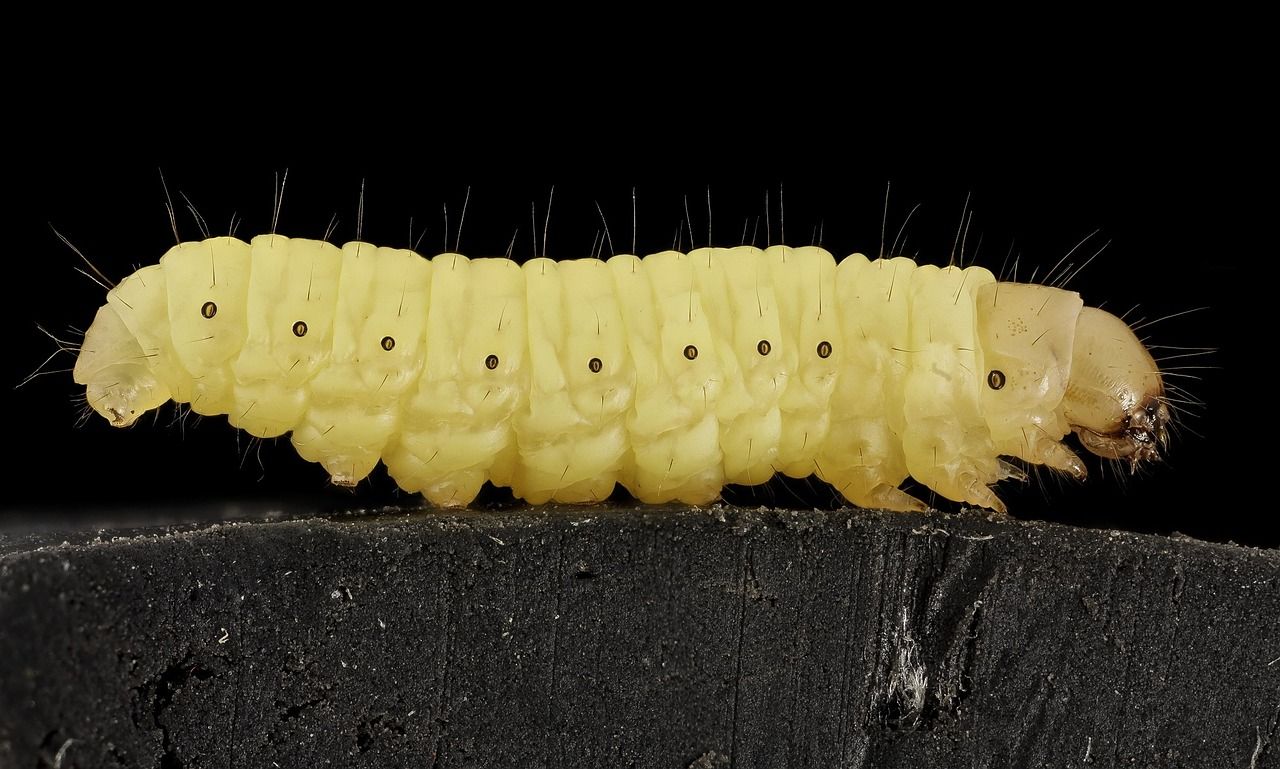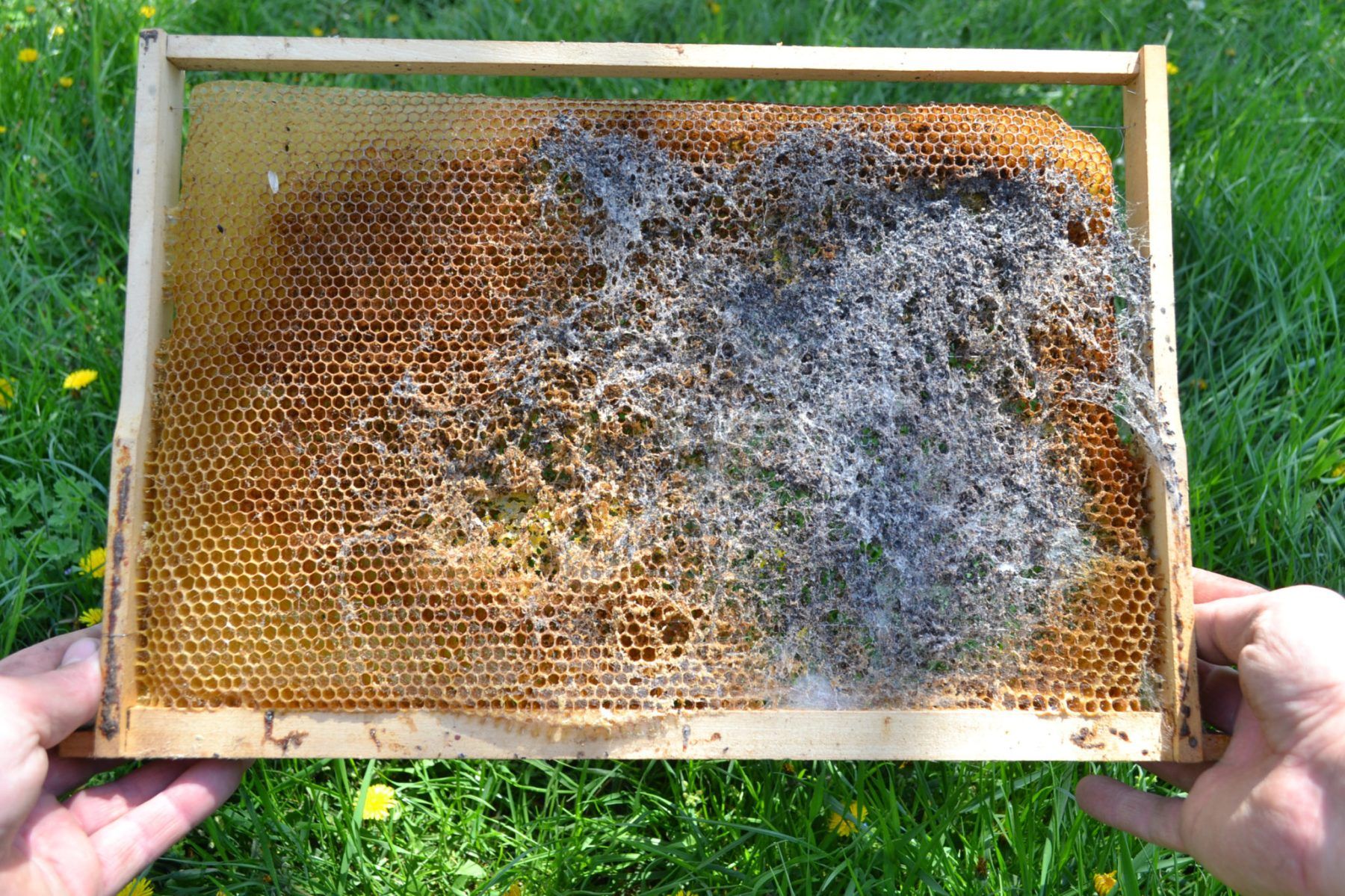They sneak into hives, lay their eggs and eat beeswax, honey, pollen or even the bee larvae or pupae. Although they are not that dangerous as varroa mites or diseases such as American Foulbrood, large amounts of wax moths are never a good sign. A healthy bee colony usually can deal with some wax moths, but for a weakened colony, wax moths can pose a threat. So, what are these creatures exactly and should you do something against them?
What are wax moths?
Wax moths is the common name for different species of moths, which try to enter beehives to lay their eggs. There are different species of wax moths, most known are the Greater wax moth (Galleria mellonella) and the Lesser wax moth (Achroia grisella). The greater wax moth is the most common and most destructive of the two [1]. The adult moths itself do not pose much of a threat to bees, its offspring however does. The larvae or «wax worms» literally eat their way through the hive feeding on wax, pollen and honey. It is said that they can even digest plastic[2].

During their feeding journey, wax worms tunnel through brood cells and honey cells, causing damage to the brood and honey leakages respectively. In the process, they leave behind a trail of webs and feces. This tunnel of silkwoven web serves as protection from the bees, as they are unable to penetrate these webs. In case of heavy infestations, entire combs might be lost and emerging brood might be trapped in the webbing. A weak colony affected by moths could collapse within a few weeks.
Life of a wax moth
A female adult moth will try to enter a beehive, if she succeeds, she can lay up to 300-600 eggs [3]. Wax moth prefer to lay their eggs in dark and remote locations in the hive. The warmer, the quicker wax moths develop. At 29°C-35°C the eggs can hatch in a few days, while at 18 °C, it might take up to 30 days[1]. The hatched larvae will immediately begin eating and spinning their webs. They eat their way through the combs and although they usually do not feed on brood, they might chew up part of the cells containing brood or honey. Once the larva is fully grown it will look for a site to spin a cocoon and pupate. Usually the larva moves to an edge and chews away a bit of the wooden outer wall of the hive. In this way they are protected and not easily removed by the bees. They emerge from their cocoons after a week or a few months (again how soon depends on the temperature) and leave the hive to mate. Adult male moths will try to attract females by making short ultrasonic sounds and through the releases of senses, called pheromones. After mating the female moth tries to lay her eggs in a beehive or comb storages (this can happen if wax moth find a way into a wax storage of the beekeeper) and the cycle starts again.

How to recognize wax moths
Wax moths can affect bee colonies in a number of ways and the earlier they are spotted the better. Most obvious is the trail of webbing and debris they leave in their larval stage.

However, a wax moth infestation is not always that clear. Wax moths prefer dark and unoccupied locations in the hive, in this way they can remain hidden for bees and beekeepers for quite a while. Also, when beekeepers store unused wax or comb prepared with wax foundations in areas wax moth can reach, they have a chance to become infected. Female wax moths would love to lay their eggs in a dark, quite garage with ample of old comb foundations for example. If infested wax or other beekeeping material is then transferred into a hive, the wax moth can spread.
Another sign can be the occurrence of bald brood. As wax moth make their way to the hive, they might feed on the cappings of brood cells and thus creating uncapped brood cells. This might look similar to the normal hygienic behaviour of workers bees, because workers bees could open a brood cell if the larva shows signs of having a disease. However, in the case of disease, brood is mostly uncapped in a scattered pattern as not all the brood is infected. Bald brood always follow a linear pattern, as the wax moths move from cells that are directly adjacent to one another[1].
So, when you see cell uncapped in a linear pattern, it is likely due to wax moths, with a scattered pattern this is likely the result of worker bees hygienic behaviour.
What to do against wax moths
Prevention is better than cure, therefore the followings steps can be taken to reduce the risks of wax moth infestations. Be aware that every colony, strong or weak and every type of comb storage, is likely to have wax moths present in any life stage status. However, only in weak or ill colonies wax moths can get the upper hand and cause problems.
Prevention
Keep your colonies strong. Honeybees and wax moths have been living with each other for centuries and under normal circumstances, honeybees have no problem dealing with them. Bees will patrol the hive and remove or kill wax moths or eggs if they find them.
Keep your hive in balance with the colony strength. Wax moths prefer dark, calm spaces. If a beehive is too large for the colony, the bees will not be present in every area. Therefore, make sure that to not put too much frames in the hive or put to many supers on the hive. When all frames are covered (80-90%) with bees and the colony is likely to grow (they have honey stored and there are enough food sources around the hive) you could expand your colonies.
Check the hive for openings. This might sound obvious but wax moth often enter a hive through small cracks or spaces between supers. It couldn’t hurt to check the hive box once in a while for openings.
Before you give a colony new frames or combs, check for moths (eggs, larvae or cocoons). Moth infestations can often start in comb storages, for example in a garage where you might have stored hives boxes with fully built frames or with wax foundations.
Cure
If wax moths do become a problem one has to move over to cure. Again, if you spot just a single wax moth, there is no need for panic. The bees are more than capable to deal with low amounts of moths themselves. These are actions you can do against wax moths:
Freezing. Wax moths do not survive freezing temperatures at any life stage. Especially in colder areas the problem of wax moths can be solved by itself in winter. However, also in colder areas wax moths could survive inside a beehive as inside the beehive it will not freeze. Storing frames or hive boxes outside and let them freeze is also a good method of preventing wax moths preying on your stored combs, otherwise you could place them in the freezer. Studies show that the colder, the quicker the wax moths die[4]:
≤ 0°C, 24 hours
-7°C 4.5 hours
-12°C 3 hours
– 15°C, 2 hours
Burning. When a comb or frame is infested with wax moth, burning all the material will ensure that no new wax moths can emerge. It might sound a bit drastic but burning can save lots of problems with wax moths in the future.
Biological. Bacillus Thuringiensis is a bacteria, which is not harmful for bees or humans, but can kill wax worms. The bacteria produce spores which contain a toxin, when wax worms feed on the spore this toxin is released. To good thing of this solution is that it does not leave behind any residues in the honey[5]. Some studies however note that it does not kill all the wax moths[6]. This method can also be combined with freezing. In this way all moths are killed by the freezing process and if any other wax moth would come after the freezing treatment, they would probably die because of the bacteria.
Chemical. There are also various chemicals methods to control wax moths. However, these are the most drastic methods and should only be used as a last resort. Further it has to be noted that, in Switzerland, only formic acid and acetic acid are allowed to use. The effects of both formic and acetic acid are believed to be comparable. The vapour of these substances kills wax moths at any life stage, however wax moth pupae in cocoons are a little more protected, which means they need to be exposed a bit longer. Usage of such chemicals can usually be avoided and should be used as a last resort. In case you have to use it, don’t do it before shortly before you plan to harvest your honey as there is a risk of honey contamination [7]. In the past other chemicals have been used such as Paradichlorobenzene and Sulphur. However, in Switzerland the use of these substances is prohibited as studies have found that honey was contaminated by this and also residues build up in the wax [5].
Wax moths as garbage collectors
Sometimes, wax moths can also have some beneficial effects. For example, by eating everything in their way, they can also help in getting rid of disease infested combs. In New Zealand, where the wax moth arrived as an exotic species, it was believed that they cause a reduction in cases of American Foulbrood [3]. Despite they are a considered a pest in beekeeping, their ability to almost eat everything in their way makes them one of nature’s interesting waste processers. The bacteria present in their digestive tracts might hold valuable insights in how we could process our own waste.
Literature
[1] Ellis, J. D., Graham, J. R., & Mortensen, A. (2013). Standard methods for wax moth research. Journal of Apicultural Research, 52(1), 1-17.
[2] Ball, P. (April 25, 2015). Plastic-eating bugs? It’s a great story – but there’s a sting in the tail. The Guardian. https://www.theguardian.com/commentisfree/2017/apr/25/plastic-eating-bugs-wax-moth-caterpillars-bee
[3] National Bee Unit. (2019) Wax Moth. Animal & Plant Health Agency.
[4] Charrière, J. D. & Imdorf, J. (1999) Protection of honey combs from wax moth damage. American Bee Journal 139(8): 627-630.
[5] Charrière, J. D. & Imdorf, J. (2004) Schutz der Waben vor Mottenschäden. Schweizerisches Zentrum für Bienenforschung, Forschungsanstalt für Milchwirtschaft.
[6] Ellis, A. M., & Hayes, G. W. (2009). Assessing the efficacy of a product containing Bacillus thuringiensis applied to honey bee (Hymenoptera: Apidae) foundation as a control for Galleria mellonella (Lepidoptera: Pyralidae). Journal of Entomological Science, 44(2), 158-163.
[7] Droz, B. & Charrière, J. D. (2015) Nach Wachsmottenbehandlung Ameisensäurerückstände im Honig. Schweizerische Bienen-Zeitung, 08/2015 p. 14-16.